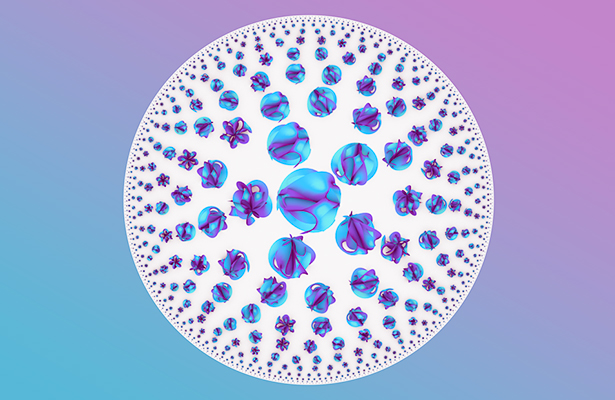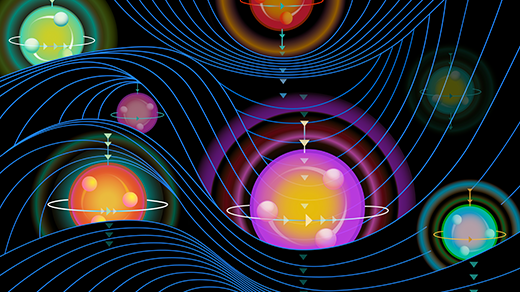In Fake Universes, Evidence for String Theory

Thirty years have passed since a pair of physicists, working together on a stormy summer night in Aspen, Colo., realized that string theory might have what it takes to be the “theory of everything.”
“We must be getting pretty close,” Michael Green (opens a new tab) recalls (opens a new tab) telling John Schwarz (opens a new tab) as the thunder raged and they hammered away at a proof of the theory’s internal consistency, “because the gods are trying to prevent us from completing this calculation.”
Their mathematics that night suggested that all phenomena in nature, including the seemingly irreconcilable forces of gravity and quantum mechanics, could arise from the harmonics of tiny, vibrating loops of energy, or “strings.” The work touched off a string theory revolution and spawned a generation of specialists who believed they were banging down the door of the ultimate theory of nature. But today, there’s still no answer. Because the strings that are said to quiver at the core of elementary particles are too small to detect — probably ever — the theory cannot be experimentally confirmed. Nor can it be disproven: Almost any observed feature of the universe jibes with the strings’ endless repertoire of tunes.
The publication of Green and Schwarz’s paper (opens a new tab) “was 30 years ago this month,” the string theorist and popular-science author Brian Greene wrote in Smithsonian Magazine (opens a new tab) in January, “making the moment ripe for taking stock: Is string theory revealing reality’s deep laws? Or, as some detractors have claimed, is it a mathematical mirage that has sidetracked a generation of physicists?” Greene had no answer, expressing doubt that string theory will “confront data” in his lifetime.
Recently, however, some string theorists have started developing a new tactic that gives them hope of someday answering these questions. Lacking traditional tests, they are seeking validation of string theory by a different route. Using a strange mathematical dictionary that translates between laws of gravity and those of quantum mechanics, the researchers have identified properties called “consistency conditions” that they say any theory combining quantum mechanics and gravity must meet. And in certain highly simplified imaginary worlds, they claim to have found evidence that the only consistent theories of “quantum gravity” involve strings.
According to many researchers, the work provides weak but concrete support for the decades-old suspicion that string theory may be the only mathematically consistent theory of quantum gravity capable of reproducing gravity’s known form on the scale of galaxies, stars and planets, as captured by Albert Einstein’s theory of general relativity. And if string theory is the only possible approach, then its proponents say it must be true — with or without physical evidence. String theory, by this account, is “the only game in town.”
“Proving that a big class of stringlike models are the only things consistent with general relativity and quantum mechanics would be a way, to some extent, of confirming it,” said Tom Hartman (opens a new tab), a theoretical physicist at Cornell University who has been following the recent work.
If they are successful, the researchers acknowledge that such a proof will be seen as controversial evidence that string theory is correct. “‘Correct’ is a loaded word,” said Mukund Rangamani (opens a new tab), a professor at Durham University in the United Kingdom and the co-author of a paper (opens a new tab) posted recently to the physics preprint site arXiv.org that finds evidence of “string universality” in a class of imaginary universes.
So far, the theorists have shown that string theory is the only “game” meeting certain conditions in “towns” wildly different from our universe, but they are optimistic that their techniques will generalize to somewhat more realistic physical worlds. “We will continue to accumulate evidence for the ‘string universality’ conjecture in different settings and for different classes of theories,” said Alex Maloney (opens a new tab), a professor of physics at McGill University in Montreal and co-author of another recent paper (opens a new tab) touting evidence for the conjecture, “and eventually a larger picture will become clear.”Meanwhile, outside experts caution against jumping to conclusions based on the findings to date. “It’s clear that these papers are an interesting attempt,” said Matt Strassler (opens a new tab), a visiting professor at Harvard University who has worked on string theory and particle physics. “But these aren’t really proofs; these are arguments. They are calculations, but there are weasel words in certain places.”
Proponents of string theory’s rival, an underdog approach called “loop quantum gravity (opens a new tab),” believe that the work has little to teach us about the real world. “They should try to solve the problems of their theory, which are many,” said Carlo Rovelli (opens a new tab), a loop quantum gravity researcher at the Center for Theoretical Physics in Marseille, France, “instead of trying to score points by preaching around that they are ‘the only game in town.’”
Mystery Theory
Over the past century, physicists have traced three of the four forces of nature — strong, weak and electromagnetic — to their origins in the form of elementary particles. Only gravity remains at large. Albert Einstein, in his theory of general relativity, cast gravity as smooth curves in space and time: An apple falls toward the Earth because the space-time fabric warps under the planet’s weight. This picture perfectly captures gravity on macroscopic scales.
But in small enough increments, space and time lose meaning, and the laws of quantum mechanics — in which particles have no definite properties like “location,” only probabilities — take over. Physicists use a mathematical framework called quantum field theory to describe the probabilistic interactions between particles. A quantum theory of gravity would describe gravity’s origin in particles called “gravitons” and reveal how their behavior scales up to produce the space-time curves of general relativity. But unifying the laws of nature in this way has proven immensely difficult.
String theory first arose in the 1960s as a possible explanation for why elementary particles called quarks never exist in isolation but instead bind together to form protons, neutrons and other composite “hadrons.” The theory held that quarks are unable to pull apart because they form the ends of strings rather than being free-floating points. But the argument had a flaw: While some hadrons do consist of pairs of quarks and anti-quarks and plausibly resemble strings, protons and neutrons contain three quarks apiece, invoking the ugly and uncertain picture of a string with three ends. Soon, a different theory of quarks emerged. But ideas die hard, and some researchers, including Green (opens a new tab), then at the University of London, and Schwarz (opens a new tab), at the California Institute of Technology, continued to develop string theory.
Problems quickly stacked up. For the strings’ vibrations to make physical sense, the theory calls for many more spatial dimensions than the length, width and depth of everyday experience, forcing string theorists to postulate that six extra dimensions must be knotted up at every point in the fabric of reality, like the pile of a carpet. And because each of the innumerable ways of knotting up the extra dimensions corresponds to a different macroscopic pattern, almost any discovery made about our universe can seem compatible with string theory, crippling its predictive power. Moreover, as things stood in 1984, all known versions of string theory included a nonsensical mathematical term known as an “anomaly.”
On the plus side, researchers realized that a certain vibration mode of the string fit the profile of a graviton, the coveted quantum purveyor of gravity. And on that stormy night in Aspen in 1984, Green and Schwarz discovered that the graviton contributed a term to the equations that, for a particular version of string theory, exactly canceled out the problematic anomaly. The finding raised the possibility that this version was the one, true, mathematically consistent theory of quantum gravity, and it helped usher in a surge of activity known as the “first superstring revolution.”But only a year passed before another version of string theory was also certified anomaly-free. In all, five consistent string theories were discovered by the end of the decade. Some conceived of particles as closed strings, others described them as open strings with dangling ends, and still others generalized the concept of a string to higher-dimensional objects known as “D-branes,” which resemble quivering membranes in any number of dimensions. Five string theories seemed an embarrassment of riches.
The next major breakthrough came in 1995, when Edward Witten (opens a new tab) of the Institute for Advanced Study in Princeton, N.J., argued in a famous lecture (opens a new tab) that all five string theories were mathematically connected and must be pieces of the same all-encompassing master theory. Witten named it M-theory. The M seems to have originally referred to membranes, but Witten has intimated that the true meaning of M awaits a better understanding of the theory, which seems to surpass the sum of its known parts. “There was a running joke that it stood for ‘mystery,’” said Steve Carlip (opens a new tab), a quantum gravity specialist at the University of California, Davis. Whatever M stands for, this mother of all manifestations of string theory restored the dream of unification.
“People had spent decades studying different types of string theories and found there were only a few consistent ones and they were the same thing,” Strassler said. “You could say, maybe that’s the only thing that can exist. Maybe there’s only one quantum gravity theory, and M-theory is it.”
Fisheye Universes
Two years after Witten’s proposal of M-theory, the Argentinian-American physicist Juan Maldacena (opens a new tab) found yet another surprising relationship, this time between strings and point particles. Maldacena’s work suggested that under certain conditions, a theory that includes gravity, be it string theory or otherwise, can be directly translated into a quantum field theory that does not have gravity.
In the theory’s simplest manifestation, the “certain conditions” require an imaginary landscape known as anti-de Sitter (AdS) space, which resembles graph paper viewed through a fisheye lens, with the squares getting smaller and smaller toward the boundary. A theory that describes how gravity works in an AdS space can be translated into an equivalent “conformal field theory” (CFT) representing point particles on that universe’s boundary. This connection enables researchers to study quantum gravity by probing the corresponding CFT. For example, they can play around with CFTs to calculate properties of quantum gravity theories in “AdS3” space — a fisheye universe with two spatial dimensions plus time. “The goal of finding quantum gravity in AdS3 could be translated into finding the right conformal field theory,” said Rangamani.
In the two most recent papers, posted within days of each other in December, separate groups led by Rangamani and Maloney set out to study the fundamental objects (whether they be strings or otherwise) in a class of simple AdS3 universes. They found that as these universes get extremely hot, the objects within them will go through an exponentially increasing number of possible “states.”
This behavior is exactly what one would expect if strings were the fundamental objects in these universes. A hotter universe allows strings to vibrate and arrange themselves in new ways, and so a hot, stringy universe will have lots of states. Point particles, by contrast, exhibit far less variety at high temperatures. “We’re getting a stringy number of states,” said Christoph Keller (opens a new tab), a postdoctoral fellow in physics at Rutgers University and co-author of one paper with Maloney and Alex Belin. “In principle it’s conceivable there’s another theory out there that isn’t string theory that also has a lot of states. We don’t know any such example.”
Some argue that this orchestra of states at high temperatures strengthens the case for the universality of string or “stringlike” quantum gravity theories in AdS3. “No one is going so far as saying that string theory is the only thing that can come out of these consistency conditions, but there’s evidence that it’s stringlike stuff,” Hartman said.
The “weasel words” in the authors’ arguments, according to Strassler, skirt around the fact that they did not calculate the exact density of states in some of the more complicated cases but merely showed that the number was higher than expected for a universe composed of point particles. “And just finding a stringy density of states — I don’t know if there’s a proof in that,” Strassler said. “This is just one property.”
Meanwhile, loop quantum gravity researchers object to the very premise that the results about AdS3 give any hint whatsoever about the nature of quantum gravity in our own universe. They note that the AdS/CFT correspondence itself has not been proven — it is only a conjecture (albeit one with wide support). More importantly, AdS space differs greatly from flat space, and universes with two spatial dimensions are far simpler than those with three. “The world is not 2+1-dimensional,” said Lee Smolin (opens a new tab), a founding and senior faculty member at the Perimeter Institute in Waterloo, Ontario, and one of the founders of loop quantum gravity. “And even in that case, there have existed for a long time counterexamples to the string universality conjecture, in the form of completely worked out formulations of quantum gravity which have nothing to do with string theory.” (String theorists argue that these particular 2+1 gravity theories differ from quantum gravity in the real world in an important way.)
Yet researchers have also applied the AdS/CFT correspondence to quantum gravity in AdS4 — a fisheye universe, but one with the same number of dimensions as our own. In 2011, Maldacena, now a professor at the Institute for Advanced Study, and his student at the time, Alexander Zhiboedov, found evidence (opens a new tab) that string theories are the only quantum gravity theories with a particular feature that reproduce general relativity at large scales. The researchers went further in a 2014 paper (opens a new tab), arguing that in any number of dimensions and space-time geometries, only theories with a certain stringlike property satisfy causality, or the notion that causes precede effects. “This is what you would expect based on the hypothesis that string theory is the only game in town,” said Zhiboedov, who is now a postdoctoral researcher at Harvard University.
The results to date appear to support the existence of “stringlike” theories, at least circumstantially. According to string theorists, stringlike theories seem somewhat likely to be string theories, as it’s difficult to picture an object that vibrates like a string but isn’t one. But then, what counts as string theory, anyway? What is M-theory? Critics have pointed out that no one knows how to use M-theory to answer all the questions one can ask about quantum gravity, or to show how nature works in all situations. String theorists might become convinced that they’re banging on the right door, without learning what, exactly, lies behind it.
So far, they have picked and chosen special, mathematically tractable testing grounds for their calculations. “There’s nothing wrong with that,” said Carlip, who considers himself a “nonaligned” quantum gravity specialist. In experimental physics, “you do the experiments you can do and not the ones you can’t.” The question, Carlip said, is “to what extent the results are general properties of quantum gravity, and to what extent they are the result of these particular simplifications.”
String theorists seem to expect that stringy results will keep appearing when they apply the AdS/CFT tool to more general classes of imaginary worlds. (They say they would be equally excited to find evidence against string universality.) A full proof that every theory of quantum gravity in AdS space is a theory with strings would be, according to Maloney, “extremely strong evidence” that the same is true in geometrically flat universes like ours.
Proof in flat universes will require completely new tools, however. Our universe does not have a spatial boundary as AdS space does; its boundary lies at the future end of time. The development of an AdS/CFT-like tool for our universe’s geometry remains in its infancy. The road to a full proof — or refutation — of string universality is long. Right now, Zhiboedov said, “this is a belief, a dream, an expectation. It’s a feeling based on work in this field.”
Correction: This article was revised on February 21, 2015, to correct Lee Smolin’s title. He is a founding and senior faculty member at the Perimeter Institute in Waterloo, Ontario.
Note: This article was updated on March 1, 2015, to provide additional context about 2+1 quantum gravity theories.
This article was reprinted on BusinessInsider.com (opens a new tab).



